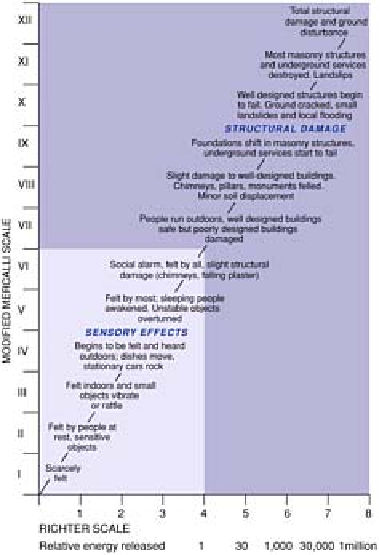Environmental Engineering Reference
In-Depth Information
Seismicity directly impacts human life through the destructive power of earthquakes,
measured on
Modified Mercalli
(descriptive) and
Richter
(logarithmic energy) scales of
severity (Figure 2). These relate chiefly to shallow, surface waves. Mercalli intensities
emphasize the human price paid in property and lives - averaging 10,000 yr
−1
globally -
by the direct destruction of housing and other structures. Among most recent earthquakes,
the Gujarat (India) earthquake of 26 January 2001 killed over 20,000 people, injured over
150,000 and destroyed or damaged 1·1 million buildings. Measuring 7·7 on the Richter
scale, it was caused by the continuing
indentation
of India into Eurasia. Earthquakes also
strike indirectly by triggering landslides,
tsunamis
, or tidal waves, and volcanic
eruptions. Indeed, although they may occur independently,
seismovolcanic
hazards are
intimately linked. Major earthquakes in Mexico City (1985), San Francisco (1989) and
Kobe (Japan, 1994) share the same global network of subduction zones as the explosive
andesitic volcanoes of Mount St Helens and Pinatubo (Figure 3). Minor British
earthquakes near Caernarfon (1984) and Shrewsbury (1990, 1996), registering 4-4·6 on
the Richter scale, remind us that older tectonic belts are not yet dead.
Figure 2
An outline of earthquake effects and damage associated
with the Modified Mercalli and Richter scales of earthquake
intensity.
Source: After Bolt et al. (1975) and Smith (1982).





